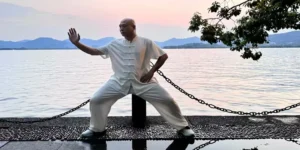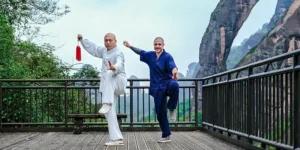Want to learn Tai Chi for health and balance? Can you truly master it alone? While tempting, self-teaching often leads to ineffective “exercise” instead of authentic Tai Chi. Real progress requires correct principles like sinking Qi and precise movement—skills best learned from a qualified master. Discover why proper guidance is essential and how to start your real Tai Chi journey right. Learn more below!

Can I Learn Tai Chi On My Own?
Tai Chi is a traditional and unique sport that has the functions of fitness and health preservation, so many people are practicing Tai Chi now. However, some self-taught people cannot practice Tai Chi. Here are some reasons why Tai Chi cannot be learned by yourself:
What selftaught Tai Chi learners practice is “Tai Chi exercises,” not Tai Chi martial arts and Tai Chi exercises. Some self-taught Tai Chi even become teachers, but they have no teacher guidance or sparring partners, so it is difficult for them to understand the principles of Tai Chi push hands, white crane wings, loose waist and hips, and qi sinking into Dantian. The Tai Chi these people do is exercise, which is not real Tai Chi at all, and it does not play the role of fitness and martial arts.
Tai Chi is a difficult sport that can hardly be learned by self-study. Now many people take it for granted that they can learn by themselves if they have a good cultural foundation, buy DVDs and books, and download videos. This is a wrong idea.
The real learning of Tai Chi lies in mastering the practice method. If you want to learn Tai Chi well, you must find a professional Tai Chi school, a disciple with kung fu, and a master to learn from. Only disciples who have truly inherited the tradition have mastered the practice method of Tai Chi, know how to teach you to practice, and let you learn authentic Tai Chi. Contemporary Chen-style Tai Chi master Shen Jiangfei said, “The key to learning Tai Chi is to master the practice method. The routine is just the surface. Whether you add or subtract, one movement will not have much impact.”
What Are The 5 Steps of Tai Chi?
The term “5 Steps of Tai Chi” isn’t a universally standardized or ancient frame like the “10 Essential Principles”. However, instructors sometimes break down the core principles or learning class into 5 key staps or focal points to help students study the fundamentals.
Here are 5 basic steps or principles:
- Forward: Lunge, knee joint does not exceed toes, vertical instep.
- Retreat: retreat backward, virtual step, center of gravity on the back leg, front foot toe touches the ground.
- Look back: step left, the front of the left foot touches the ground, center of gravity horizontally, retract the right foot, step together.
- Follow step: step forward with the left heel, the front of the right foot touches the ground. Then, step right, right foot touches the ground, center of gravity horizontally, retract the left foot, step together.
- Fixed: refers to the feet are shoulder-width apart, squat down, the knee joint cannot exceed the toes, and the knee joint is as vertical as possible to the instep.
5 steps aren’t rigid steps you complete one after the other and then move on. Tai chi beginners focus heavily on 1 & 2, but aspects of 3, 4, and 5 are introduced early and deepened over time. These “5 steps” are essentially a condensed way of teaching the core principles found in Yang Chengfu’s Ten Essentials and similar lists from other styles.
How Many Times a Week Should You Do Tai Chi?
The frequency of your Tai Chi practice will be determined by your goals. The following are common goals and how often you should practice Tai Chi per week:
For people who want to lose weight and relieve stress, practicing 2-5 times a week can improve balance and relax the body and mind without overexerting. If you want to work on your balance and physical fitness, practicing 5-7 times a week can enhance muscle memory and improve your body and intuition.
For those who want to deepen their martial arts routines through Tai Chi, practice at least 5-7 times a week or more to improve and deepen their understanding. Daily practice helps internalize the movements, cultivate agility, and enhance inner strength and coordination.
Tai Chi beginners should practice 2-3 times a week, spending more time learning the basic movements and letting your body adapt slowly. Beginners should take it step by step and focus on quality rather than quantity.
What Are the 3 Main Aspects of Tai Chi?
The 3 core aspects of Tai Chi practice:
Mind (Yi): Intention, Awareness, and Focus
Directing your conscious awareness fully to the present moment and the movement. It’s about cultivating a calm, focused, yet relaxed state of mind. “Yi” specifically refers to using your intention to lead the movement, not brute muscle force. Maintaining mental focus on your breath, body alignment, weight shifts, and the flow of energy.
Body (Shen): Physical Structure, Alignment, and Movement
Upright but relaxed posture, sinking the shoulders and elbows, differentiating substantial and insubstantial legs, turning from the waist, moving with integrated power, and maintaining stability and balance.
Qi (Qi / Ch’i): Vital Energy, Breath, and Internal Force
Deep, natural, abdominal breathing synchronized with movements. The sensation of warmth, tingling, heaviness, or flowing energy is often reported with practice. Developing “Peng Jing.” Moving with smooth, flowing power that feels effortless yet strong.
Is Tai Chi Strength Training?
Tai Chi is strength training, but it’s very different from conventional weightlifting or resistance training. It builds strength in specific, unique ways.
Yes, Tai Chi is strength training. It builds functional, stabilizing, and endurance strength, particularly in the legs and core. It focused on efficiency, balance, internal connection, and resilience, using body weight, slow control, and mindful movement.
Tai Chi builds the deep, resilient, coordinated, and balanced strength that supports longevity, mobility, and graceful movement, rather than raw power. For many health and wellness goals, especially as we age, the strength Tai Chi builds is incredibly valuable.
Is Tai Chi Resistance Training?
Yes, Tai Chi is resistance training. Because your muscles work against the resistance provided by your own body weight and gravity during slow, controlled movements and static holds. It is NOT traditional resistance training with external weights.
It is effective for building the specific types of strength crucial for daily function, fall prevention, joint health, and longevity: endurance strength, stabilizing strength, functional strength, and connective tissue strength.
How to Train Tai Chi?
Step-by-step guide to learning Tai Chi:
Find a qualified instructor, especially one who is certified by a recognized lineage or style, such as Master Shen Jiangfei, 32nd generation of Chen Tai Chi. A good tai chi instructor will ensure that you learn correctly and safely from the beginning. Don’t rush into practicing long routines. Learn the basic postures first, and once you have mastered the basics, move on to a specific Tai Chi style.
At Shen Jiangfei International Martial Arts School, we offer authentic Tai Chi classes, rooted in a strong tradition and Master Shen Jiangfei’s decades of martial arts skills. Our structured course content:
- Solid foundation: First master the core principles and body mechanics.
- Step-by-step: patient, clear instruction, customized to your personal pace.
- Holistic approach: Integrates physical training, breathing exercises, mental focus, and inner energy training.
- Experienced instruction: Learn from senior instructors who are committed to passing on the essence of martial arts.


